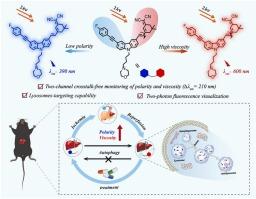Crosstalk-free two-channel visualization and precise assessment of autophagy-regulated hepatic ischemia-reperfusion injury by a two-photon fluorescent probe
IF 8
1区 化学
Q1 CHEMISTRY, ANALYTICAL
引用次数: 0
Abstract
Hepatic ischemia-reperfusion injury (HIRI) is a universal surgical complication that seriously affects patient prognosis. Many studies have shown that its process is closely associated with cellular autophagy, and the inhibition of autophagy can slow down HIRI. Autophagy is intensely related to changes in the lysosomal microenvironment. Therefore, real-time fluorescence visualization of autophagy level fluctuations through monitoring lysosomal microenvironment could be a viable strategy for effectively assessing HIRI. In our work, we reported a two-photon fluorescent probe Ly-NJ, which responds to changes in lysosomal polarity and viscosity in two crosstalk-free channels. The correlation between lysosomal polarity/viscosity during HIRI and autophagy levels was found. The results of two-photon fluorescence imaging as well as Western blot revealed that the increase in lysosomal polarity and viscosity during prolonged hepatic ischemia-reperfusion corresponded to the increased levels of autophagy. In addition, two-channel imaging results showed that the use of autophagy inhibitor 3-methyladenine (3-MA) in HIRI can recover the lysosomal polarity and viscosity to the initial level of control group, indicating HIRI can be alleviated by inhibiting the autophagy level. Furthermore, luteolin and silymarin were testified to have a mitigating effect on HIRI by monitoring the variation of blue and red channels, which was similar with that of 3-MA. In vivo fluorescence imaging in HIRI model mice further supported the retarding effects of above agents on HIRI. These studies indicated that Ly-NJ has the potential for clinical application in visualizing HIRI, and will provide a promising imaging tool for timely prophylactic treatment and intraoperative monitoring of HIRI.

求助全文
约1分钟内获得全文
求助全文
来源期刊

Sensors and Actuators B: Chemical
工程技术-电化学
CiteScore
14.60
自引率
11.90%
发文量
1776
审稿时长
3.2 months
期刊介绍:
Sensors & Actuators, B: Chemical is an international journal focused on the research and development of chemical transducers. It covers chemical sensors and biosensors, chemical actuators, and analytical microsystems. The journal is interdisciplinary, aiming to publish original works showcasing substantial advancements beyond the current state of the art in these fields, with practical applicability to solving meaningful analytical problems. Review articles are accepted by invitation from an Editor of the journal.
 求助内容:
求助内容: 应助结果提醒方式:
应助结果提醒方式:


